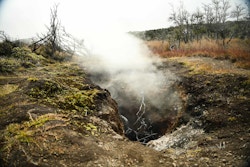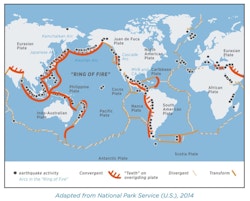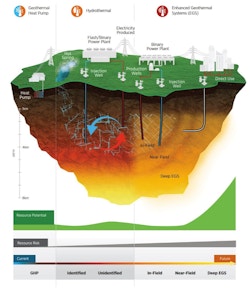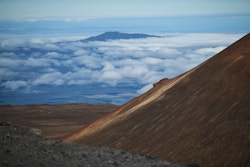Geothermal energy, powered by Earth
Geothermal energy is an ancient technique relying on the Earth’s internal heat to generate energy. Accounting for less than 1% of the global energy mix, this renewable energy is less known than solar and wind energy but holds an interesting potential in some geographies. Let’s discover more with Beatrice Cordiano, environment, energy and sustainability expert at Energy Observer.

Big Island, Hawaii
An outsider with incredible potential
The environmental impact of fossil fuels has raised awareness on the need of sustainable energy solutions that don't emit greenhouse gases while meeting society’s energy needs. Among the most promising renewable resources is geothermal energy, which has many advantages: abundance, resource availability and low emissions.
According to a recent study conducted by the Massachusetts Institute of Technology (MIT), the potential geothermal energy available on our planet is estimated to be around 12.6 x 1024 MJ. Just think that in 2018 the world energy consumption totalled approximately 4 x 1014 MJ, this means that geothermal alone could theoretically cover the world’s energy needs for billion years!
Of course, not all that glitters is gold, and of this extensive amount -if emerging technologies such Enhanced Geothermal Systems (EGS) keep developing granting access to previously inaccessible resources – only a small fraction could be potentially used: 2 x 1018 MJ, thus covering our needs for roughly 5,000 years.
Let's try to better understand what this type of energy source is and how it works.

Figure 1. Global share of total energy supply by source, 2018. Geothermal energy accounts for less than 1%.
An energy source used since Roman times
The word “geothermal” comes from ancient Greek - geo (earth) and thermos (heat) - and it literally means heat within the earth. This form of renewable energy is based on the exploitation of the natural heat stored in the Earth’s sub-surface. Humans have been tapping this power since Roman times, when they harnessed it to bathe and heat houses, for example in Pompeii.

Figure 2. Geothermal energy sources
Temperatures underneath the substrate are estimated to be in the range of 200-1,000 °C, while the core of the earth is assumed to reach 3,500-4,000 °C due to the hot molten rock named magma. For this reason, the thermal heat flows naturally by conduction generating a temperature difference of around 25°C/km [5], which is used for heating/cooling applications or tapped to generate electricity.
Geothermal energy can be found virtually anywhere. However, geothermal fluids, namely water and steam, do not always rise towards the surface naturally. They do so where the crust is non-continuous and allows them to find their way up through fractures and discontinuities. In fact, the most active geothermal systems are often found in volcanically or seismically active areas and along tectonic plates.

Figure 3. Tectonic plates and global geological activity
Relying on natural elements
In both cases, a mile-deep wells must be drilled to access underground reservoirs and extract geothermal fluids, which are then often re-injected in the ground without having been in contact with the atmosphere.
Certain conditions must be met to ensure the practicability of a geothermal project. First, the reservoir must be accessible, and wells must be drilled at depths of interest: techniques like those used to extract oil and gas are adopted. Moreover, the reservoir must present a sufficient productivity: this means that to guarantee long-term production at economically reasonable levels, the rate of extraction must balance the aquifer groundwater natural production. If this is not the case, reinjection is essential.
Very hot water or steam are produced, and their energy is converted into a marketable product (electricity, process heat, or space heat).

Figure 4. The diversity of geothermal resources and applications: potential, risk and outlook.
The power of this energy transfer shows itself thanks to nature elements such as volcanoes, geysers, hot springs and blowholes. The traditional geothermal activity has naturally developed in volcanic sites, namely around the ‘ring of fire’ (the entire coastline surrounding the Pacific Ocean), from California down to the coasts of Chile, in ‘hot spots’ such as Hawaii and Iceland. In these areas, applications mainly address renewable power generation, which needs very high temperatures and pressures of the fluids entering the turbines.
Despite the absence of volcanoes in central Europe, geothermal heat generation is quickly growing thanks to moderate drilling costs and to the use of low temperature (between 90 and 110 °C) geothermal systems, whose free heat is used for central heating for people’s home in places like France, Germany, Switzerland and Denmark or to heat greenhouses in Netherlands.
The deep geothermal energy solutions
A relatively new technique which still has room for development is represented by the so called EGS (Enhanced Geothermal System). The thermal energy of deep rocks is tapped creating a system of artificial interconnected fractures through hydraulic stimulation to cause steam - who knows, maybe in the future it will be CO2 - circulation and rise. This approach significantly expands the geographical area suitable for geothermal power production and is very similar to that of ‘fracking’, a technique used to extract natural gas and oil and which. This comes though with a major issue: earthquakes. Removing water or steam from the underground can cause the land above to sink slowly over time and reinjecting the fluids to compensate this effect can sometimes trigger tiny earthquakes. The problem is when high pressures migrate and interact with existing cracks. In this case, the waves get bigger and difficult to handle. For this reason, companies implement safety measures via a “traffic light”: if the earthquake is small, the light is green, and the extraction can go ahead. When the shakes increase, operations must be adjusted and when red lights up and the earthquake is too big, everything must stop, at least temporarily.
Such event recently occurred in the East of France, where an earthquake was caused by a deep geothermal plant in a former coal mine.
A promising future under certain conditions
As everything in the world, geothermal energy has its own drawbacks. The extraction process must be thought following strict design constraints imposed by prevailing geologic, hydrologic and lithologic conditions. Any waste product needs to be properly treated and disposed. Furthermore, safety measures must be adopted taking into consideration that the handled fluids are very hot, under pressure and might cause equipment corrosion. All this results in very high plant upfront capital costs - just think that up to 40-50% of the total project costs is due to the well construction alone [8]- which can be faced with technology development, government subsidies and societal support.
Nonetheless, geothermal energy presents incredible advantages. Firstly, it can be considered essentially limitless since the replenishment of the underground aquifers is almost continuous and if it is not, techniques are adopted as mentioned above.
Sun isn’t always shining, wind isn’t always blowing but geothermal is stable 365 days/year, 24 hours/day, regardless of atmospheric.
For this reason, it can provide base load stability representing a reliable and constant power supply which doesn’t need any storage. It is green, it doesn’t require combustion, it is widespread distributed, it is scalable. Moreover, many similarities can be found between geothermal heat extraction and the fossil fuels industry, especially concerning drilling techniques and equipment.
Not only it has the smallest land footprint compared to other alternative energy sources, but also it can have a positive impact on job creation since a lot of workers are needed to run geothermal power plants.
I like to think that there is surely a promising future for developing geothermal energy, if it’s done safely and respectfully of the environment.
Sources
MIT, The Future of Geothermal Energy, Impact of Enhanced Geothermal Systems (EGS) on United States in the 21st Century
IEA (2020), Renewables Information: Overview, IEA, Paris https://www.iea.org/reports/re...
IRENA (2017), Geothermal Power: Technology Brief, International Renewable Energy Agency, Abu Dhabi
Energia geotermica, una grande risorsa nascosta - Encyclopédie des énergies
Ruggero Bertani, Geothermal Energy: an overview on resources and potential
Ruggero Bertani, World Geothermal Generation 2001-2005:State of the Art, Proceedings World Geothermal Congress 2005, Antalya, Turkey (2005)
Gerald W. Huttrer, Geothermal Power Generation in the World 2015-2020 Update Report, Proceedings World Geothermal Congress 2020, Reykjavik, Iceland (2020)
5 things you should know about geothermal energy - Baker Hughes
Lessons South Korea solving geothermal earthquake problem - Stanford.edu
Geothermal Technologies Office, US DOE. GeoVision: Harnessing the Heat Beneath Our Feet - Analysis Inputs and Results. United States: N. p., 2019. Web. doi:10.15121/1572361
Geothermal Energy - British Geological Survey

